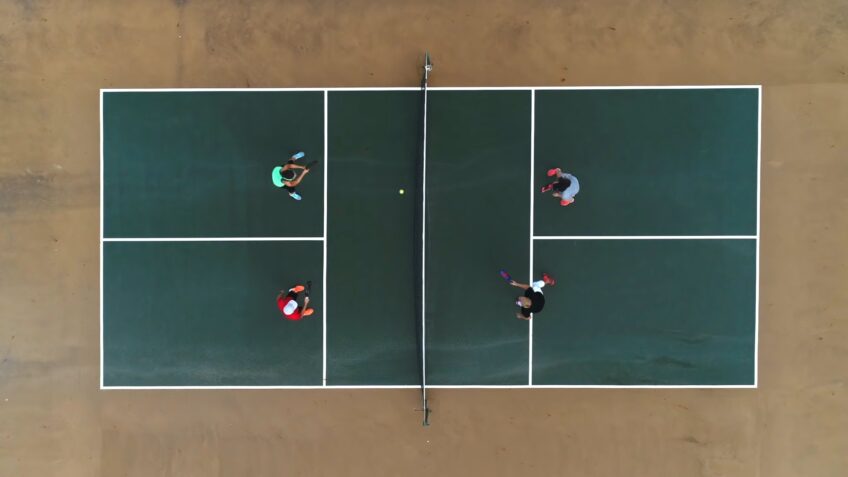Pickleball courts are constructed according to official USAPA regulations. These regulations specify the required dimensions for a court according to the game’s regulations. Knowing the dimensions of a pickleball court can help you with setting up your own pickleball court, either indoors or outdoors.
In this article, we will provide an overview of the dimensions of a pickleball court, as well as other important information.
Definition of Pickleball
Pickleball is a sport quite similar to tennis, but one that is played in an area approximately 1/3 the size. It can be played on a court 20 feet wide x 44 feet long for singles play and 20 x 64 for doubles play. The pickleball court resembles a tennis court, with the same set of boundary lines, except for two main differences: the setting has no tramlines, and the court is stripped shorter in comparison to that of a full-sized tennis court.
The net used for pickleball is lower than that of tennis and is hung from two poles that are 36 inches tall and affixed 34 feet apart from each other. The pickleball itself varies in size—however, it must weigh between 0.8 to 1.2 ounces and have an outer diameter of 2 3/8 inches—and is made out of plastic or wood composite materials with holes cut into them to help reduce wind resistance when it’s in flight.
Popularity of Pickleball
The sport of pickleball has experienced tremendous growth in recent years, particularly in the United States. According to USAPA, there were over 200,000 players in the United States alone at the start of 2019. As more and more people become familiar with this unique racquet sport and its rules, interest continues to grow rapidly.
Pickleball is played on a court that measures 20 feet wide by 44 feet long (for doubles). The net is an especially important part of the court since it dictates and affects many different aspects of play—how a ball bounces, who will serve first, how shots are returned and so much more. A regulation pickleball net is 34 inches high at either end with a center height of 36 inches. The court walls then provide for regulation distances for all legal shots—a minimum 8-foot side wall to prevent players from hitting up against it and overhangs that extend at least 6 feet from each line on the court. Pickleball courts may be divided using lines that mark specific areas like singles boxes and service courts; these measurements are always 1 foot from the net’s edge.
Court Dimensions
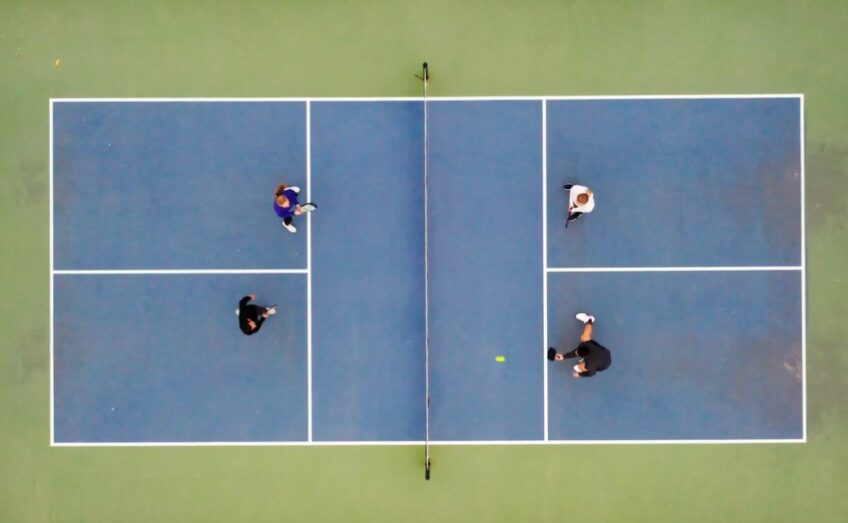
When it comes to pickleball, the court size is a key factor in the game. Pickleball court dimensions are regulated by the USA Pickleball Association (USAPA). These dimensions determine the size of the area within which players can move and the size of the court boundary lines.
Let’s take a look at the court size for singles and doubles play.
Size of the Court
The official size of a pickleball court is 20 x 44 feet. The length should measure no more than 44 feet and no less than 20 feet from the sidelines to the baseline. The width of the court is usually measured using a cord or string where it comes to line up with the outer and inner edges of the sideline markers.
Additionally, before play begins, both sides of the court should be marked with center lines that divide each side into two equal parts. For recreational play, small adjustments in dimensions may be made in order to accommodate smaller or irregular-shaped areas, but these alternative dimensions must remain within a certain range of distances allowed by the rule.
Net Height
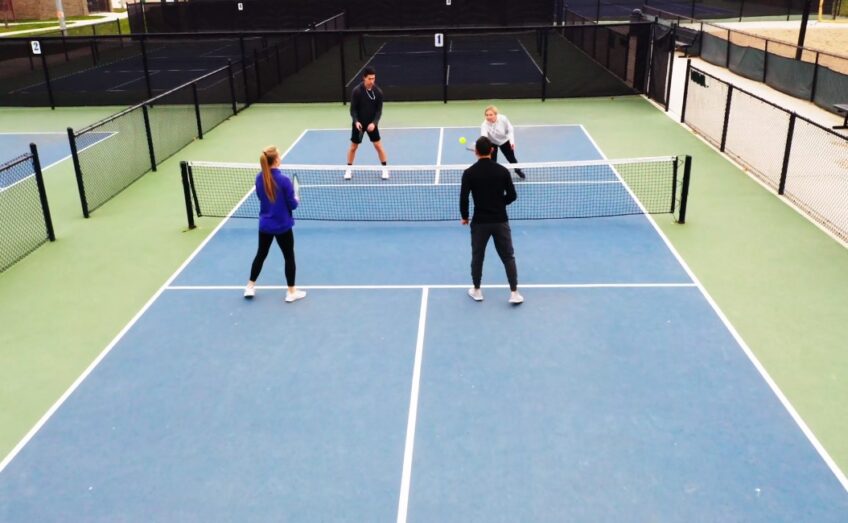
The net for a regulation pickleball court will be hung at a height of 36 inches (just over three feet) in the center, and 34 inches (just under three feet) on each team’s right and left sides. This height should, as with other measurements, be consistent throughout the court.
The net will measure 44 inches (3 feet 8 inches) wide and the middle post stabilizing the net should be centered in this width measurement. The middle post is generally made of metal and may run between 20 and 24 inches high or even slightly higher in order to ensure that it can support a heavy-duty sports-grade net. Nets hung between recreational posts may not require as much structural integrity.
Markings
The markings on a pickleball court are designed to establish playable boundaries for the players. The interior court lines are painted white and the double pickleball lines should be yellow. In between the left outer and inner side lines, 6′ from the net, another line is marked for non-volley play (the “kitchen”). Ideally, all lines should use non-toxic water-based paints that can be removed from the playing surface after use.
The pickleball court also has an around-the-net area which has its own set of rules. The area known as ‘no man’s land’ is marked outside of either 7 feet or 8 feet of space (unless especially specified) in all directions from both sides of the net. If a ball drops into this area, it is considered out regardless if it drops on your own side or your opponent’s courtside.
Equipment
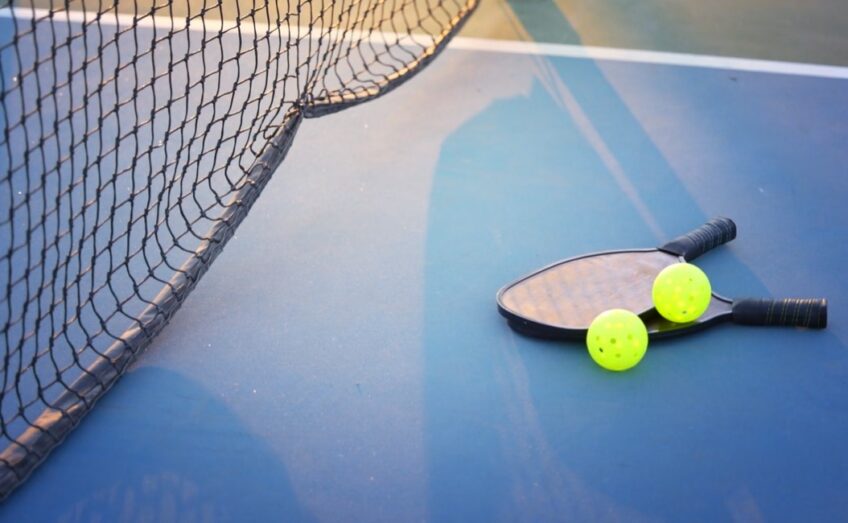
When it comes to setting it up, a variety of equipment is needed. From the right net and court dimensions to the right kind of paddle, it requires specific pieces of equipment.
To get a better understanding of the dimensions of a pickleball court and the equipment needed, let’s dive into the details.
Pickleball
Pickleball is typically played with a perforated plastic ball similar to a whiffle ball, which is smaller than a tennis ball and slightly bigger than a ping-pong ball. Each pickleball should be white with green or black printing on it, and it should weigh between 0.78 ounces and 0.935 ounces (22-26.5 grams). The circumference should range from 2/? to 2½ inches between 27/8 inches (73 mm) and 2?/8 inches (74 mm). Its diameter should be no less than 7/8 inch (22 mm) and no greater than 1 inch (25.4 mm).
To ensure accurate dimensions, the USAPA recommends using official pickleball with the “USAPA” logo printed on them as these have been tested thoroughly for size, shape, weight, bounce, and marking consistency.
Paddles
Pickleball paddles are typically made with a solid core of either graphite, aluminum, or composite materials and are then covered with a textured face called a “skin”. The paddle skin is made of either vinyl or some type of rubberized material that is designed to increase the amount of “spin” that you can generate when playing pickleball.
Paddles range in weight from 6-10 ounces and come in a variety of sizes and shapes that suit different skill levels and playing styles. Beginners will want to select larger paddles that have wider heads as they will have more power behind their shots, while advanced players may opt for smaller more nimble paddles.
Choose a paddle that feels comfortable in your hands, as well as confidence-inspiring when hitting the ball.
Nets
Nets in pickleball must be 36 feet long and hung at a height of 34 inches at the sidelines and 36 inches at the center. They should also be constructed of 20-pound test nylon, have taped top and bottom edges, and have UV-protected taping or other similar protective measures.
Nets must also have 6-inch squares extending two feet above the tape line at both sides or unless a special arrangement has been made with the sanctioning body.
If any of these elements are missing from your net, you may need to purchase a specialized net that meets all requirements.
Safety Considerations
When playing the game of pickleball, safety should be kept in mind. Not having a properly sized court can lead to injuries simply from being too close to the net when playing a shot. Understanding the dimensions of a pickleball court and adhering to them is essential for safety.
Let’s take a look at the safety considerations of having a pickleball court of the proper size.
Proper Clothing
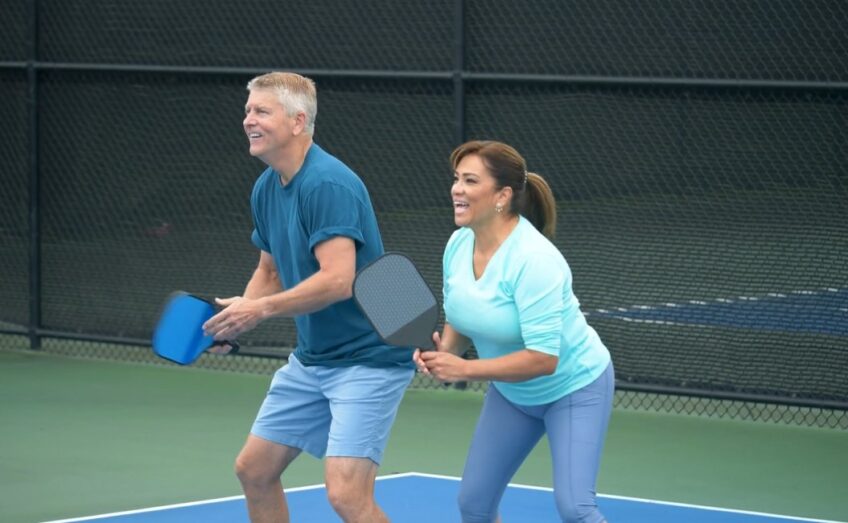
When playing pickleball, it is important to wear proper clothing for your own safety and for the safety of other players. Appropriate attire includes comfortable and non-restrictive workout clothes that are also lightweight and breathable to allow freedom of movement. Clothing should not be too long or too loose as it can present a tripping hazard or get caught in the paddle.
Additionally, close-toed shoes or athletic sneakers should be worn for protection from the court surface, to maintain balance and traction, as well as absorb shock from jumping when playing close to the net. Open-toed shoes such as sandals should never be worn on a pickleball court.
Protective Gear
Protective gear is especially important when playing pickleball. Proper padding, protective eyewear, and footwear are essential to ensure a safe playing environment. Padding should be worn at all times, such as knee and elbow pads, headgear, and safety glasses. If a player chooses to play without proper protective gear, they may be at high risk for significant injury in the event of an accident or intense gameplay.
Play only at established pickleball courts to reduce the risk of dangerous play conditions such as exposed sharp objects, holes, or uneven terrain. Players can better prepare themselves for an enjoyable game by wearing the following protective equipment:
- Knee Pads: Knee pads are worn to offer additional cushioning for your knees in case of falls or roughness during gameplay.
- Elbow Pads: Elbow pads help protect elbows from scrapes and bruises caused by hard surfaces, intense game movements, or falls during aggressive turns on courts with good traction
- Headgear: The risk of head injuries increases when playing fast sports like pickleball; therefore wearing a helmet/headgear is recommended, especially during advanced levels of play
- Safety Glasses/Goggles: Due to the intensity levels associated with pickleball matches, eye protection is highly recommended at all levels of play – recreational through competitive
- Quality Sports Shoes: Protective shoes can help reduce the chance of slips due to slippery surfaces and uneven terrain on outdoor courts
Proper Footwear
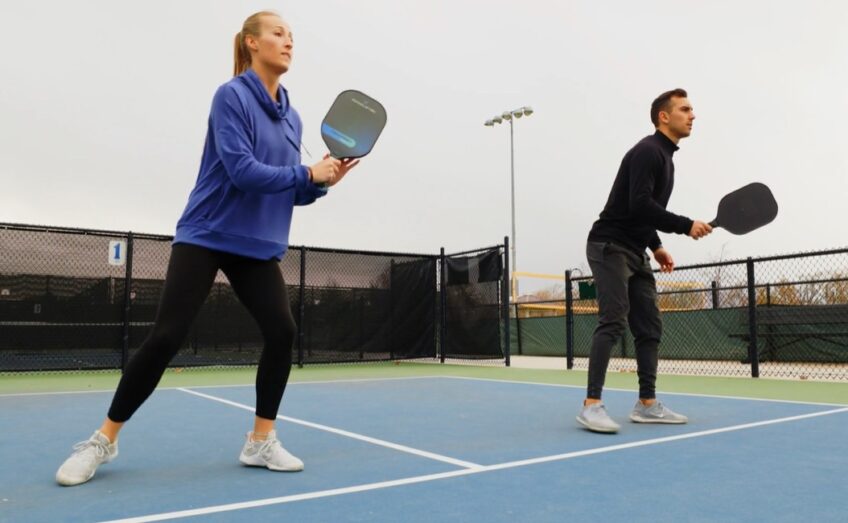
It is important to wear appropriate and comfortable shoes or sneakers when playing pickleball. To avoid unnecessary injury, it is best to avoid wearing sandals, flip-flops, or open-toed footwear while playing.
Players’ shoes should be non-marking and provide grip to both the lines of the court and the surface of the court itself. Shoes should have enough cushioning and arch support before use in order to protect against knee pain, foot pain, and possible foot damage.
Additionally, players should ensure that their shoelaces are properly secured—this can help prevent slips during strenuous activity.
Maintenance
Maintaining it can help you ensure that it is safe for play and meet the requirements for tournaments. Proper maintenance of a Pickleball court involves inspecting the dimensions of the court, inspecting nets and net posts, and checking court surfaces and equipment.
Cleaning the Court
In order to ensure its longevity and create safe playing conditions, it is necessary to keep it clean. This means regularly sweeping it free of dirt and debris, removing dead leaves and branches, as well as correcting any divots created while playing.
It is also essential to make sure that any cracks or uneven playing surfaces are repaired in a timely fashion, to avoid further wear and tear. To remove weeds from the court surface, it may be necessary to use a weed killer formulated specifically for hard court play area surfaces—please reference your local home improvement center for suggestions on which products are best suited for this purpose.
Finally, it’s always advisable to check for standing water after rainfall on all courts due to potential slippery surface conditions—remove any standing water with a squeegee or mop before continuing play.
Repairing Equipment
Having the right equipment is vital for a great pickleball experience. In addition, maintaining and repairing equipment such as net poles, rackets, and balls regularly is essential for optimal performance. Keeping all equipment well-maintained not only contributes to enhanced play but also helps extend the life of the items.
To repair courts and equipment, regular inspection is key. Check the net poles for signs of rust or wear and repair any holes or defects in surfaces with chink or court patching paint to ensure high playing quality. Damaged net poles should be replaced with new ones that are securely fastened into place to prevent flexing during play which can lead to warped courts or injured players.
It is also important to check rackets frequently for any signs of damage such as worn-out strings or loose parts that may need replacing. Balls should also be inspected for imperfection, holes, and wear marks on their surface which indicate they have been in use for too long and must be replaced if so.
Overall, ensuring all pieces of needed equipment are properly maintained will help create a safe playing environment where everyone can enjoy a game of pickleball that lives up to its full potential!
Upgrading Equipment
In addition to regular maintenance and upkeep, it is recommended to periodically check the condition of the equipment and make upgrades when necessary. Equipment that may need upgrading includes nets, yard lines, permanent poles, and court padding (the latter is only for indoor courts).
Nets should be checked annually for wear. Replace worn nets with either a regulation or a junior net depending on the court’s intended use. Yard lines should also be inspected annually. If the lines are wearing away or faded, consider upgrading them using permanent markers or official yard line tape. Indoor courts may benefit from additional padding along the walls if necessary.
The permanent poles should be maintained regularly with fresh paint to prevent rusting and corrosion, especially if they remain outdoors. The poles can also be secured firmly in place with spikes driven through ground anchors into concrete or hard surfaces below the surface of the play area, taking care not to harm or damage any electrical wires below ground level.
FAQs
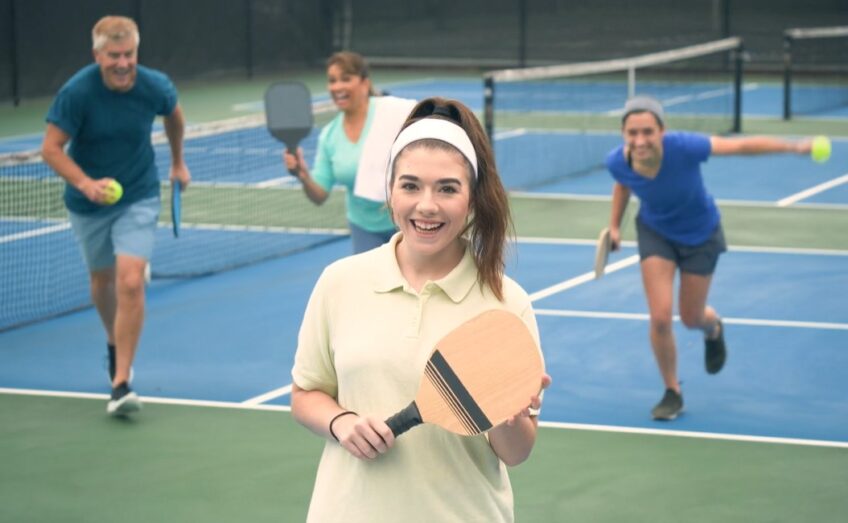
What is the distance between the net and the baseline?
The distance between the net and the baseline is 22 feet.
How wide is the non-volley zone?
The non-volley zone, also known as the kitchen, is 7 feet from the net.
What is the distance between the sidelines?
The distance between the sidelines is 20 feet.
Can I use a smaller net for my backyard court?
Yes, you can use a smaller net for it, but make sure it is regulation height.
What materials can I use to create a pickleball court?
Materials commonly used for a pickleball court include asphalt, concrete, or even a plastic interlocking tile system.
Is a building permit required for a backyard pickleball court?
It depends on your local zoning and building codes. It is recommended to check with your city or county building department.
Can I paint the lines on my backyard pickleball court?
Yes, you can use paint or tape to mark the lines on it.
How do I ensure that my court is level?
You can use a level or a laser level to ensure that it is leveled.
How much does it cost to build a backyard pickleball court?
The cost can vary depending on the materials used and the size but typically ranges from $3,000 to $10,000.
Conclusion
In conclusion, understanding the dimensions of a pickleball court is crucial if you want to enjoy the game to the fullest. By following the guidelines on court size, you can easily set up your own pickleball court in your backyard or any other suitable location. Make sure you adhere to the regulations and measurements of the court to avoid any inconveniences or problems during the game. It’s always better to be well-informed and prepared when it comes to playing pickleball. So, whether you’re a beginner or a seasoned player, familiarizing yourself with the court dimensions is an important step towards mastering the game and having a fun and enjoyable experience.

